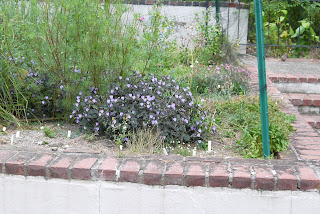Pardon the u-posts, they are there to support mesh which keeps the deer away. I started by enclosing certain beds, now I have built a fence of mesh around the entire back yard but I haven't removed some of the earlier fencing yet in case a deer does get in. We don't have many deer here but they are present and the damage they can do is astounding. My students know that I hate them, that I regard them as little more than hooved disease carrying rats. The damage they inflict on the local flora is only exceeded by what our species has done, and we have favored the deer greatly by removing the wolves that were their main predator and by creating "edge" habitats which they prefer. They now have reached such numbers that people are killed or injured each year running into them with their cars, countless more victims have suffered or died from Lyme Disease, erlichiosis, babiosis, anaplasmosis, and Powassan virus (one third of victims die from it, fortunately it is rare so far) which are transmitted by ticks that live on deer. But some folks may protest, well don't rodents carry ticks too? But comparing a rodent with ticks to a deer with ticks is like comparing the passenger capacity of a tricycle to a 747 Jumbo Jet. Plus rodents are easier to control. There are also devices which can render the rodents free of ticks that can be placed in your yard, but there is no such thing for the monstrous hooved version. Meanwhile our woodlands are being stripped of the trilliums, ladyslipper orchids, and other spring wildflowers that the deer hunger after. I remember seeing vast swathes of trilliums in Ithaca, NY each spring when I was a student in the woodlands not far from the Cornell University campus, but I have heard that such displays are a thing of the past due to a greatly increased deer population. I think I saw one deer in the evening at the edge of the campus at night once in my 10 years there as a student, but during my last summer visit for a long weekend about 4 years ago I saw one on West Campus at 11 in the morning! Clearly something has to be done about them, but in the meantime the best defense a gardener has is to build a fence to exclude or at least make life difficult for them. In the front yard which they do have access to, I regularly spray Liquid Fence and plant mostly toxic or smelly plants that deer don't like. I will also chase and throw things at them if I see them, the neighbors must wonder about that one. I want my yard to be as unwelcoming as possible and in fact I think I may have changed their usual route through the neighborhood. As it stands right now, the cars are their major "predator" in this area, with coyotes a distant second. I know folks who live right near large parks or other tracks of woodlands who have large herds roam through their properties but there aren't any really large woodlands very close by and so they don't have too many places to hide during the day around here. So between the cars and increasing houses in the area I think that conditions are less favorable for them so that their numbers are unlikely to get larger in my immediate neighborhood. And that is a good thing.
Back to the Tinantia. I have one plant that sowed itself into a pot with a small laeliocattaleya hybrid orchid in it and it survives the winters indoors growing in the bark with the orchid. Outside self sown seedlings appear when the weather gets warm and rapidly grow to blooming size. I have to thin some of them out to allow room for other plants but it is not a difficult task. It would make a superb container plant as well on account of the foliage, and the flowers are nothing to sneeze at when it is in full bloom.



No comments:
Post a Comment